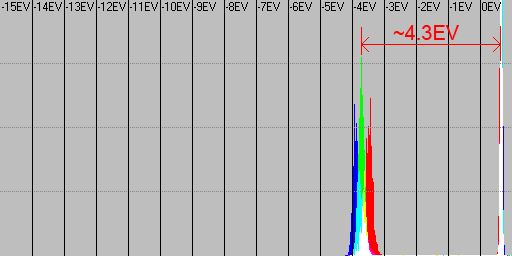Thanks, I will keep those figures: 5 orders of magnitude static (16,6EV) and 9 orders adaptive (29,9EV), although I think specially the last could be a bit optimistic depending on how demanding we are about distinguising detail and colour.
I was doing some tests to find out the EV between the max and min luminance (i.e. the maximum displayable DR) on my monitor and on a print copy, and found lower values than some of the figures found in the literature.
For my monitor (I shot a black and white pattern) I found a difference between pure white and pure black of about 6,7EV:

For the print copy (same pattern displayed on the monitor) I measured a difference of about 4,3EV:

Of course the figures may vary depending on many parameters such as monitor calibration, ambient lighting, type of paper, ink,... but these should be the standard order of magnitude.
In the reference:
HDR images we find this table:
• 100,000:1. The ratio of an outdoor scene from shadow to a sunlit area. About 100 orders of magnitude.
• 10,000:1. The ratio for the human eye’s dynamic range is at least an eight order of magnitude luminance range with adaptation and five orders of magnitude of dynamic range without adaptation.
• 300:1 to 500:1. The ratio of an LCD monitor. The ratio is usually referred to as the contrast ratio. About 3 orders of magnitude.
• 300:1. The ratio of a display with sufficient range for medical diagnosis.
• 160:1. The ratio of a printer page from paper white to the black colorant.
• 150:1. The ratio for the HVS local contrast at high spatial frequencies and at small regions where very high contrast cannot be perceived. It is this ratio that allows the HVS to view the dynamic range of the printed page as acceptable.
• 90:1. The ratio of encoding for sRGB is less than two orders of magnitude.
I don't understand very well the matching between the contrast figures on the left, and the orders of magnitude they talk about. E.g. 100,000:1 for 100 orders of magnitude???
For the LCD monitor they say 300:1 to 500:1, i.e. 8,2EV and 9EV, I wonder if they include changing monitor adjustments from its purest black to its brightest achievable white.
They give 160:1 (7,3EV) for the printer page, that seems too much for me.
I was wondering how ambient lighting could affect DR of devices.
- For instance in a projector, ambient light definitively reduces contrast (that is why lights are to be switched off during projections).
- The same could apply to a monitor, where blacks could easily become 'washed' because of ambient light while whites do not benefit so much from it.
- On the contrary I think ambient light shouldn't affect contrast on a printed copy, or it could even benefit of a higher contrast the higher the ambient light is, I don't know.
Just to think a bit about. Regards